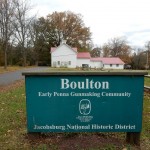James Henry: Pioneer Conservationist, Environmental Activist & Forestry Education Advocate

Photo: Jim Wilson
James Henry (1809-1895) is not a well-known figure in Pennsylvania’s conservation history. Yet he should be recognized as an early advocate for the cause of clean water and conservation education. He helped author Pennsylvania’s first bill to protect and restore the Commonwealth’s streamside forests and water quality and lobbied for its passage. He also encouraged the Pennsylvania Forestry Association, the American Forestry Congress in Boston, and the USDA Forestry Division in Washington to establish schools of forestry in the nation’s colleges and universities.

Photo: Jim Wilson
The Henry family is most famous for the iron and gun making industries they established in Nazareth, Jacobsburg, Henry’s Forge, and Boulton in Northampton Pennsylvania. As early as the 1780s, they harnessed waterpower from Bushkill Creek to forge the first bar of iron in Northampton County and make tens-of-thousands of rifles, muskets, shotguns, and pistols for the Fur Trade and frontiersmen in the American West, mountain men in the Rockies, US soldiers in the War of 1812, Union soldiers in the Civil War, and hunters and trappers across the country. In partnership with the Delaware and Lehigh National Heritage Corridor, PA Department of Conservation & Natural Resources and Jacobsburg Historical Society, the Henry family’s early American industrial history and heritage is well preserved and interpreted for the public at the Boulton Historic Site, in the Jacobsburg National Historic District at Jacobsburg State Park, in Bushkill Township.
At the height of the early logging industry in the 1880s, James met with Pennsylvania State Senator Jeremiah Hess from Northampton County to seek his help in petitioning the Commonwealth to do something about the uncontrolled storm water erosion and soil sediment pollution of streams and rivers across the state. Senator Hess, trusting in James’ grasp of the situation, understanding of ecological principles, and formidable writing skills, encouraged Henry to draft a bill to address the issue point by point.

Photo: Jim Wilson
Introduced in 1885, as an “An act to encourage the planting of trees near the springs and along the water courses of the Commonwealth of Pennsylvania”. While the bill failed to pass its third and final consideration of the State House, It was the first legislation proposal to address the protection of waterways by creating a state nursery for the planting of riparian forest buffers. And was a precursor to the creation of the state’s Forestry Commission and Forest Reserve System to rehabilitate the state’s forest and water resources though the creation of a forest nursery system, as was the longtime vision for which James Henry so tirelessly fought.
James Henry also petitioned the Pennsylvania Forestry Association in Harrisburg, the American Forestry Congress in Boston, and the USDA Forestry Division in Washington to recommend and file support for the bill in Harrisburg. At the same time, he was lobbying these lawmakers and agencies to support his forestry bill, he also petitioned them to aggressively support and promote forestry as part of the academic curriculum in institutions of higher learning in Pennsylvania and across the nation. In a letter to the American Forestry Congress, James wrote, “In conjunction with this scheme (his forestry bill), however, no suggestion could be more urgent than to appeal to all our Colleges to open schools of Forestry. There will be but lukewarm movements made in our Legislatures, looking to the encouragement of dendrology among our citizens, until our representatives themselves have been educated up to the subject.”
James Henry was both a man of his time and a man ahead of it. Over 130 years after James Henry first articulated his vision and wrote a legislative bill for forested buffers, the restoration and protection of streamside forests is today a subject of community concern and conservation initiatives throughout Pennsylvania. And because of early education advocates like Henry, forestry and environmental science programs are today offered at state colleges and universities across Pennsylvania and throughout the nation.
Understanding the ecological and economic benefits of riparian buffers today, the Commonwealth of Pennsylvania now offers grant funding to municipalities and nonprofit organizations across the state to reforest streamside buffers that have been lost. In fact, the D&L Corridor has awarded tens-of- thousands of state dollars to its partner organizations in Lehigh and Northampton Counties for streamside buffer restoration and education though its Mini Grant Program with Lehigh Valley Greenways and the PA Department of Conservation & Natural Resources.
And today, certain land trusts and government agencies even offer fee simple and easement purchases of streamside properties to be managed as permanent riparian buffers for water quality and flood protection—a fact that would come as a delightful surprise to James Henry, who in the 1880s wrote, “It remains a problem however, not easily solved, how these borders of our streams could now be appropriated by our Commonwealth, as their purchase would be out of the question. Without the timely protection of these bordering lands and securing them for an exclusive arboriculture, our water supply will diminish at a fearful rate, and floods will ravage the districts through which the creeks and rivers flood more and more every year.”
Jim Wilson, Parks Recreation Specialist, Northampton County Division of Parks & Recreation


